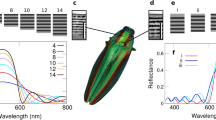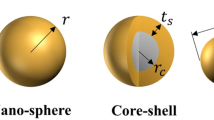Abstract
The rational design of photonic nanostructures consists of anticipating their optical response from systematic variations of simple models. This strategy, however, has limited success when multiple objectives are simultaneously targeted, because it requires demanding computational schemes. To this end, evolutionary algorithms can drive the morphology of a nano-object towards an optimum through several cycles of selection, mutation and cross-over, mimicking the process of natural selection. Here, we present a numerical technique that can allow the design of photonic nanostructures with optical properties optimized along several arbitrary objectives. In particular, we combine evolutionary multi-objective algorithms with frequency-domain electrodynamical simulations to optimize the design of colour pixels based on silicon nanostructures that resonate at two user-defined, polarization-dependent wavelengths. The scattering spectra of optimized pixels fabricated by electron-beam lithography show excellent agreement with the targeted objectives. The method is self-adaptive to arbitrary constraints and therefore particularly apt for the design of complex structures within predefined technological limits.
This is a preview of subscription content, access via your institution
Access options
Subscribe to this journal
Receive 12 print issues and online access
$259.00 per year
only $21.58 per issue
Buy this article
- Purchase on Springer Link
- Instant access to full article PDF
Prices may be subject to local taxes which are calculated during checkout






Similar content being viewed by others
References
Tan, S. J. et al. Plasmonic color palettes for photorealistic printing with aluminum nanostructures. Nano Lett. 14, 4023–4029 (2014).
Lindfors, K. et al. Imaging and steering unidirectional emission from nanoantenna array metasurfaces. ACS Photon. 3, 286–292 (2016).
Black, L.-J., Wang, Y., de Groot, C. H., Arbouet, A. & Muskens, O. L. Optimal polarization conversion in coupled dimer plasmonic nanoantennas for metasurfaces. ACS Nano 8, 6390–6399 (2014).
Valev, V. K., Baumberg, J. J., Sibilia, C. & Verbiest, T. Chirality and chiroptical effects in plasmonic nanostructures: fundamentals, recent progress, and outlook. Adv. Mater. 25, 2517–2534 (2013).
Kauranen, M. & Zayats, A. V. Nonlinear plasmonics. Nat. Photon. 6, 737–748 (2012).
Albella, P., Alcaraz de la Osa, R., Moreno, F. & Maier, S. A. Electric and magnetic field enhancement with ultralow heat radiation dielectric nanoantennas: considerations for surface-enhanced spectroscopies. ACS Photon. 1, 524–529 (2014).
Bakker, R. M. et al. Magnetic and electric hotspots with silicon nanodimers. Nano Lett. 15, 2137–2142 (2015).
Ginn, J. C. et al. Realizing optical magnetism from dielectric metamaterials. Phys. Rev. Lett. 108, 097402 (2012).
Kuznetsov, A. I., Miroshnichenko, A. E., Fu, Y. H., Zhang, J. & Luk'yanchuk, B. Magnetic light. Sci. Rep. 2, 492 (2012).
Schmidt, M. K. et al. Dielectric antennas—a suitable platform for controlling magnetic dipolar emission. Opt. Express 20, 13636–13650 (2012).
Cao, L., Fan, P., Barnard, E. S., Brown, A. M. & Brongersma, M. L. Tuning the color of silicon nanostructures. Nano Lett. 10, 2649–2654 (2010).
Traviss, D. J., Schmidt, M. K., Aizpurua, J. & Muskens, O. L. Antenna resonances in low aspect ratio semiconductor nanowires. Opt. Express 23, 22771–22787 (2015).
Zhao, W. et al. Full-color hologram using spatial multiplexing of dielectric metasurface. Opt. Lett. 41, 147–150 (2016).
Yu, Y. F. et al. High-transmission dielectric metasurface with 2π phase control at visible wavelengths. Laser Photon. Rev. 9, 412–418 (2015).
Shcherbakov, M. R. et al. Enhanced third-harmonic generation in silicon nanoparticles driven by magnetic response. Nano Lett. 14, 6488–6492 (2014).
Wiecha, P. R. et al. Enhanced nonlinear optical response from individual silicon nanowires. Phys. Rev. B 91, 121416 (2015).
Fu, Y. H., Kuznetsov, A. I., Miroshnichenko, A. E., Yu, Y. F. & Luk'yanchuk, B. Directional visible light scattering by silicon nanoparticles. Nat. Commun. 4, 1527 (2013).
Sivanandam, S. & Deepa, S. Introduction to Genetic Algorithms (Springer, 2008).
Forestiere, C. et al. Particle-swarm optimization of broadband nanoplasmonic arrays. Opt. Lett. 35, 133–135 (2010).
Feichtner, T., Selig, O., Kiunke, M. & Hecht, B. Evolutionary optimization of optical antennas. Phys. Rev. Lett. 109, 127701 (2012).
Forestiere, C. et al. Genetically engineered plasmonic nanoarrays. Nano Lett. 12, 2037–2044 (2012).
Forestiere, C., He, Y., Wang, R., Kirby, R. M. & Dal Negro, L. Inverse design of metal nanoparticles’ morphology. ACS Photon. 3, 68–78 (2016).
Ginzburg, P., Berkovitch, N., Nevet, A., Shor, I. & Orenstein, M. Resonances on-demand for plasmonic nano-particles. Nano Lett. 11, 2329–2333 (2011).
Macías, D., Adam, P.-M., Ruíz-Cortés, V., Rodríguez-Oliveros, R. & Sánchez-Gil, J. A. Heuristic optimization for the design of plasmonic nanowires with specific resonant and scattering properties. Opt. Express 20, 13146–13163 (2012).
Bigourdan, F., Marquier, F., Hugonin, J.-P. & Greffet, J.-J. Design of highly efficient metallo-dielectric patch antennas for single-photon emission. Opt. Express 22, 2337–2347 (2014).
Mirzaei, A., Miroshnichenko, A. E., Shadrivov, I. V. & Kivshar, Y. S. Superscattering of light optimized by a genetic algorithm. Appl. Phys. Lett. 105, 011109 (2014).
Chen, P. Y., Chen, C. H., Wu, J. S., Wen, H. C. & Wang, W. P. Optimal design of integrally gated CNT field-emission devices using a genetic algorithm. Nanotechnology 18, 395203 (2007).
Wang, M., Alparslan, A., Schnepp, S. M. & Hafner, C . Optimization of a plasmon-assisted waveguide coupler using FEM and MMP. Progr. Electromag. Res. B 59, 219–229 (2014).
Kessentini, S., Barchiesi, D., Grosges, T. & Lamy de la Chapelle, M. Particle swarm optimization and evolutionary methods for plasmonic biomedical applications. In 2011 IEEE Congress on Evolutionary Computation (CEC), 2315–2320 (IEEE, 2011).
Jung, J. Robust design of plasmonic waveguide using gradient index and multiobjective optimization. IEEE Photon. Technol. Lett. 28, 756–758 (2016).
Deb, K. Multi-objective Optimization Using Evolutionary Algorithms Vol. 16 (Wiley, 2001).
Shegai, T. et al. A bimetallic nanoantenna for directional colour routing. Nat. Commun. 2, 481 (2011).
Aouani, H. et al. Ultrasensitive broadband probing of molecular vibrational modes with multifrequency optical antennas. ACS Nano 7, 669–675 (2013).
Dopf, K. et al. Coupled T-shaped optical antennas with two resonances localized in a common nanogap. ACS Photon. 2, 1644–1651 (2015).
Giannini, V. & Sánchez-Gil, J. A. Excitation and emission enhancement of single molecule fluorescence through multiple surface-plasmon resonances on metal trimer nanoantennas. Opt. Lett. 33, 899–901 (2008).
Harutyunyan, H., Volpe, G., Quidant, R. & Novotny, L. Enhancing the nonlinear optical response using multifrequency gold-nanowire antennas. Phys. Rev. Lett. 108, 217403 (2012).
Celebrano, M. et al. Mode matching in multiresonant plasmonic nanoantennas for enhanced second harmonic generation. Nat. Nanotech. 10, 412–417 (2015).
Girard, C. Near fields in nanostructures. Rep. Prog. Phys. 68, 1883–1933 (2005).
Goh, X. M., Ng, R. J. H., Wang, S., Tan, S. J. & Yang, J. K. Comparative study of plasmonic colors from all-metal structures of posts and pits. ACS Photon. 3, 1000–1009 (2016).
Li, Z., Clark, A. W. & Cooper, J. M. Dual color plasmonic pixels create a polarization controlled nano color palette. ACS Nano 10, 492–498 (2016).
Beume, N., Naujoks, B. & Emmerich, M. SMS-EMOA: multiobjective selection based on dominated hypervolume. Eur. J. Oper. Res. 181, 1653–1669 (2007).
Martin, O. J. F., Girard, C. & Dereux, A. Generalized field propagator for electromagnetic scattering and light confinement. Phys. Rev. Lett. 74, 526–529 (1995).
Chaumet, P. C. & Sentenac, A. Simulation of light scattering by multilayer cross-gratings with the coupled dipole method. J. Quant. Spectrosc. Radiat. Transf. 110, 409–414 (2009).
Gallinet, B. & Martin, O. J. F. Electromagnetic scattering of finite and infinite 3D lattices in polarizable backgrounds. Theoret. Comput. Nanophoton. 1176, 63–65 (2009).
Biscani, F., Izzo, D. & Yam, C. H. A global optimisation toolbox for massively parallel engineering optimisation. Preprint at https://arxiv.org/abs/1004.3824 (2010).
Edwards, D. F. in Handbook of Optical Constants of Solids (ed. Palik, E. D.) 547–569 (Academic, 1997).
Girard, C., Dujardin, E., Baffou, G. & Quidant, R. Shaping and manipulation of light fields with bottom-up plasmonic structures. New J. Phys. 10, 105016 (2008).
Draine, B. T. The discrete-dipole approximation and its application to interstellar graphite grains. Astrophys. J. 333, 848–872 (1988).
Han, X.-L., Larrieu, G., Fazzini, P.-F. & Dubois, E. Realization of ultra dense arrays of vertical silicon nanowires with defect free surface and perfect anisotropy using a top-down approach. Microelectron. Eng. 88, 2622–2624 (2011).
Guerfi, Y., Carcenac, F. & Larrieu, G. High resolution HSQ nanopillar arrays with low energy electron beam lithography. Microelectron. Eng. 110, 173–176 (2013).
Acknowledgements
The authors thank P. Salles and G.-M. Caruso for technical assistance. This work was partly supported under a ‘Campus Gaston Dupouy’ grant by the French government, Région Midi-Pyrénées, and the European Union (ERDF), by the computing facility centre CALMIP of the University of Toulouse (grant no. P12167) and by the LAAS-CNRS micro and nanotechnologies platform, a member of the French RENATECH network.
Author information
Authors and Affiliations
Contributions
P.R.W., V.P. and A.A. designed the research. C.G., A.A. and P.R.W implemented the codes and performed the simulations. A.L. and G.L. fabricated the samples by EBL. P.R.W and V.P. performed the dark-field scattering experiments. All authors contributed to the data analysis, figure preparation and manuscript writing.
Corresponding authors
Ethics declarations
Competing interests
The authors declare no competing financial interests.
Supplementary information
Supplementary information
Supplementary information (PDF 969 kb)
Rights and permissions
About this article
Cite this article
Wiecha, P., Arbouet, A., Girard, C. et al. Evolutionary multi-objective optimization of colour pixels based on dielectric nanoantennas. Nature Nanotech 12, 163–169 (2017). https://doi.org/10.1038/nnano.2016.224
Received:
Accepted:
Published:
Issue Date:
DOI: https://doi.org/10.1038/nnano.2016.224
This article is cited by
-
Probing the optical near-field interaction of Mie nanoresonators with atomically thin semiconductors
Communications Physics (2023)
-
Inverse design of glass structure with deep graph neural networks
Nature Communications (2021)
-
Partitioned gradient-index phononic crystals for full phase control
Scientific Reports (2020)
-
Global optimization of metasurface designs using statistical learning methods
Scientific Reports (2019)
-
Pushing the limits of optical information storage using deep learning
Nature Nanotechnology (2019)



